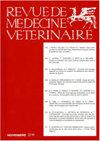Efecto del isoespintanol y el timol en la actividad antioxidante de semen equino diluido con fines de congelación
Q2 Veterinary
引用次数: 2
Abstract
A wide variety of antioxidants that were evaluated for freezing equine semen failed to yield satisfactory results in maintaining their quality and fertility. Isoespintanol and thymol are molecules of natural origin with a high antioxidant activity, which makes them potentially useful for reducing semen oxidative stress during cryopreservation. This study aimed to evaluate the effect of isoespintanol and thymol on total antioxidant and enzymatic activity of equine semen diluted for freezing purposes. The semen of five Colombian creole horses was diluted in a freezing medium, divided into three aliquots that were randomly assigned to treatments with isoespintanol (40 μM), thymol (50 μM), or control (no antioxidant). Total antioxidant capacity (TAC) was evaluated using ORAC and FRAP tests. Catalase (CAT), superoxide dismutase (SOD) and glutathione peroxidase (GPx) activity were evaluated by enzymatic assays. The statistical evaluation was performed using mixed models, correlation analysis, and comparison of means by Tukey’s test. SOD and GPx activities were lower for isoespintanol (6.7 ± 2.2 U/ml and 0.16 ± 0.02 U/ml), compared to thymol (6.9 ± 2.2 U/ml and 0.20 ± 0.02 U/ml) and to control (7.2 ± 2.2 U/ml and 0.22 ± 0.02 U/ml) (p 0.05). Isoespintanol reduces SOD and GPx activity in equine semen diluted for freezing purposes.异espintanol和百里香酚对马精液冷冻稀释抗氧化活性的影响
各种用于冷冻马精液的抗氧化剂在保持其质量和生育能力方面都没有取得令人满意的结果。异斯皮醇和百里香酚是天然来源的分子,具有很高的抗氧化活性,这使得它们在低温保存期间可能有助于减少精液氧化应激。本研究旨在探讨异刺皮醇和百里香酚对冷冻稀释马精液总抗氧化活性和酶活性的影响。将5匹哥伦比亚克里奥尔马的精液在冷冻培养基中稀释,分成3个等分,随机分为异刺皮醇(40 μM)、百里香酚(50 μM)和对照组(无抗氧化剂)。采用ORAC和FRAP试验评价总抗氧化能力(TAC)。酶法测定过氧化氢酶(CAT)、超氧化物歧化酶(SOD)和谷胱甘肽过氧化物酶(GPx)活性。统计学评价采用混合模型、相关分析、均数比较采用Tukey检验。与百里酚(6.9±2.2 U/ml和0.20±0.02 U/ml)和对照(7.2±2.2 U/ml和0.22±0.02 U/ml)相比,异斯皮醇组SOD和GPx活性(6.7±2.2 U/ml和0.16±0.02 U/ml)较低(p 0.05)。异刺甾醇降低马精液中SOD和GPx活性。
本文章由计算机程序翻译,如有差异,请以英文原文为准。
求助全文
约1分钟内获得全文
求助全文
来源期刊

Revue De Medecine Veterinaire
农林科学-兽医学
CiteScore
1.30
自引率
0.00%
发文量
0
审稿时长
18-36 weeks
期刊介绍:
The Revue de Médecine Vétérinaire publishes four kinds of text:
1) Scientific reviews on subjects related to veterinary and comparative medicine. Suggested length: 10 to 30 typed pages.
2) Original reports on fundamental or applied research. Suggested length: 10 to 15 typed pages.
3) Continuous education articles, that should be easily understandable by non-specialists. Suggested length: 10 to 15 typed pages.
4) Clinical reports. Suggested length: 5 to 15 typed pages.
The publication can be done in French language or English language.
For an article written in English by not english native speakers authors, the manuscript must be subjected by attesting that it was read again by an anglophone scientist or a scientific translator.
The authors must certify that the manuscript was not published or subjected for publication to another review.
The manuscript must be accompanied by a sheet signed by all the joint authors indicating their agreement for the tender of the manuscript.
The publication is free but a financial participation could be required for the photographs color. An estimate will be sent to collect the agreement of the authors.
 求助内容:
求助内容: 应助结果提醒方式:
应助结果提醒方式:


